There are different types of radioactive series that radioactivie decay follows. In the given table, Column I shows the end or stable nuclei which any one of the radioactive series produces, Column II shows the mass number of different tpes of ratioactive series and Column III shows different values of n different radioactive sereis.
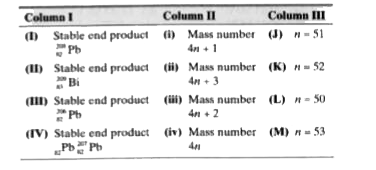
Determine the characteristics of thorium.
A
(III)(ii)(L)
B
(I)(iv)(K)
C
(II)(i)(M)
D
(II)(i)(K)
Text Solution
The correct Answer is:A, B, C, D
|
Updated on:21/07/2023
Related Playlists
- BOOK - RESNICK AND HALLIDAYCHAPTER - THE NUCLEUSEXERCISE - PRACTICE QUESTIONS(Integer Type)7videos
THE NUCLEUS
- BOOK - RESNICK AND HALLIDAYCHAPTER - THE NUCLEUSEXERCISE - PRACTICE QUESTIONS (Linked Comprehension)12videos
THE NUCLEUS
- BOOK - RESNICK AND HALLIDAYCHAPTER - THE KINETIC THEORY OF GASESEXERCISE - PRACTICE QUESTIONS72videos
THE KINETIC THEORY OF GASES
- BOOK - RESNICK AND HALLIDAYCHAPTER - UNITS AND MEASUREMENT EXERCISE - PRACTICE QUESTIONS (MATRIX-MATCH)11videos
UNITS AND MEASUREMENT
Similar Practice Problems
- Question 1 - Select One or More
There are different types of radioactive series that radioactivie decay follows. In the given table, Column I shows the end or stable nuclei which any one of the radioactive series produces, Column II shows the mass number of different tpes of ratioactive series and Column III shows different values of n different radioactive sereis.
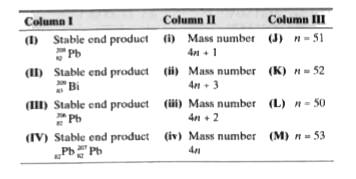
Determine the characteristics of actinium.A(III)(i)(K)B(I)(i)(L)C(IV)(ii)(J)D(I)(iv)(M) - Question 1 - Select One or More
There are different types of radioactive series that radioactivie decay follows. In the given table, Column I shows the end or stable nuclei which any one of the radioactive series produces, Column II shows the mass number of different tpes of ratioactive series and Column III shows different values of n different radioactive sereis.
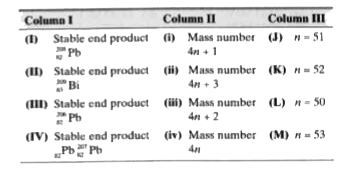
Determine the characteristics of neptunium.A(I)(iii)(K)B(IV)(iii)(J)C(I)(ii)(M)D(II)(i)(K) - Question 1 - Select One
Different hydrogen spectral series have different wave- lengths. In the given table, Column I shows the values of energy levels between which electronic transition takes place, Column II shows the formula of maximum wave- length of different spectral series and Column III shows the formula of minimum wavelength of different spectral series
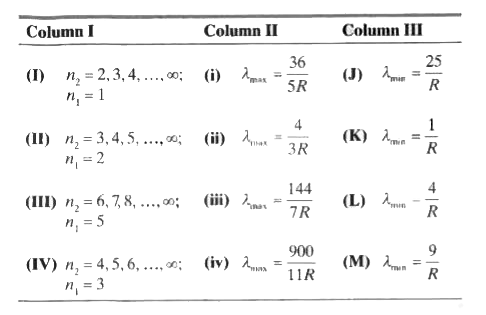
Determine the wavelengths, λmaxandλmin for Balmer series.A(II)(i)(L)B(III)(ii)(K)C(I)(i)(L)D(I)(iii)(J) - Question 1 - Select One or More
Different hydrogen spectral series have different wave- lengths. In the given table, Column I shows the values of energy levels between which electronic transition takes place, Column II shows the formula of maximum wave- length of different spectral series and Column III shows the formula of minimum wavelength of different spectral series

Determine the wavelength, λmaxandλmin for Paschen series.A(III)(i)(L)B(IV)(i)(J)C(III)(iv)(J)D(IV)(iii)(M) - Question 1 - Select One or More
Different hydrogen spectral series have different wave- lengths. In the given table, Column I shows the values of energy levels between which electronic transition takes place, Column II shows the formula of maximum wave- length of different spectral series and Column III shows the formula of minimum wavelength of different spectral series
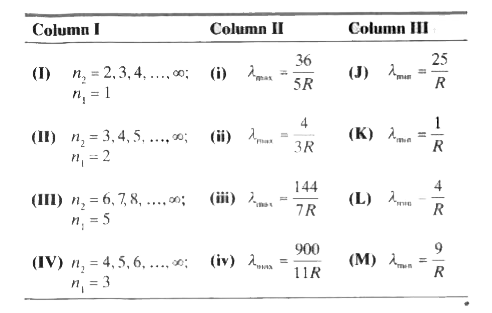
Determine the wavelengths λmaxandλmin for Pfund series.A(I)(ii)(M)B(III)(iv)(J)C(II)(ii)(K)D(II)(iv)(M) - Question 1 - Select One
In each equation, there is a table having 3 columns and 4 rows. Based on the table, there are 3 questions. Each question has 4 options (a), (b), (c ) and (d), ONLY ONE of these four options is correct.
There are different types of lasers. In the given table, Colums I shows the properties of different lasers or material used in lasers, Column II shows the different names of the lasers and Column III shows the uses of different type of lasers.

What are the characteristics of semiconductor laser?A(I) (iii) (K)B(IV) (iii) (J)C(I) (ii) (M)D(II) (i) (K) - Question 1 - Select One or More
Many side particles are produced when radioactive decay takes place.In the given table, Column I shows the charge of the different side particles, Column II shows the mass and Column III shows the ionization power of these side particles.
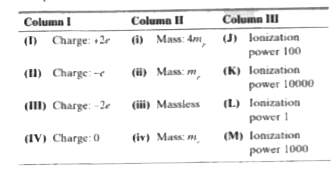
What are the characteristics of α- particle?A(I)(ii)(J)B(IV)(i)(M)C(II)(iv)(K)D(I)(i)(K) - Question 1 - Select One or More
Many side particles are produced when radioactive decay takes place.In the given table, Column I shows the charge of the different side particles, Column II shows the mass and Column III shows the ionization power of these side particles.
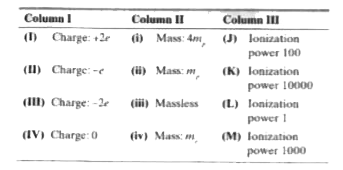
What the characteristics of gamma - particles?A(IV)(iii)(L)B(I)(i)(K)C(III)(iii)(J)D(I)(ii)(M) - Question 1 - Select One or More
Many side particles are produced when radioactive decay takes place.In the given table, Column I shows the charge of the different side particles, Column II shows the mass and Column III shows the ionization power of these side particles.
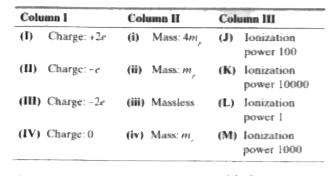
What the characteristics of β- particle?A(III)(ii)(J)B(II)(iv)(J)C(II)(iii)(K)D(I)(i)(M) - Question 1 - Select One
There are mainly two types of combinations of resistors in a circuit, series and parallel. In the given table, Column I shows voltages of different arrangements of resistors, Column II shows different arrangement of resistors and Column III shows currents of different arrangements of resistors.
What are the conditions when resistor is in the parallel network?
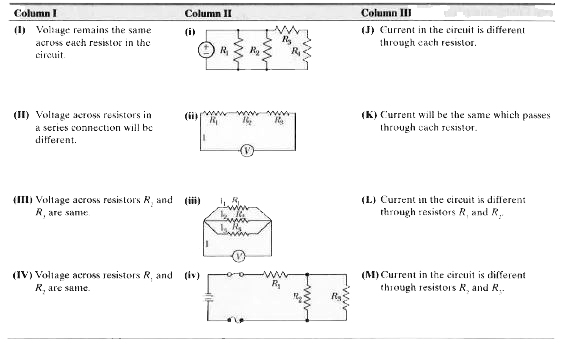 A(I) (ii) (J)B(IV) (ii) (M)C(II) (ii) (J)D(I) (iii) (J)
A(I) (ii) (J)B(IV) (ii) (M)C(II) (ii) (J)D(I) (iii) (J)

